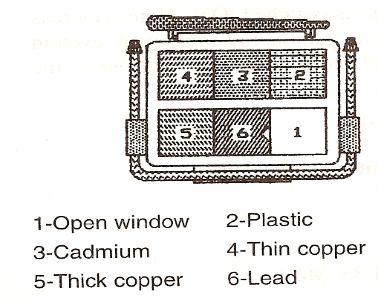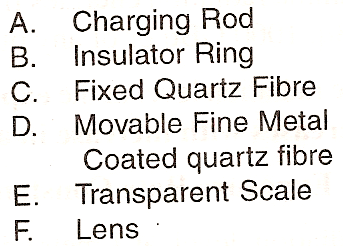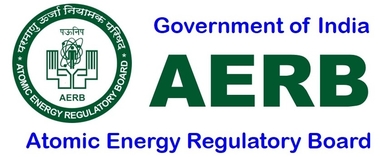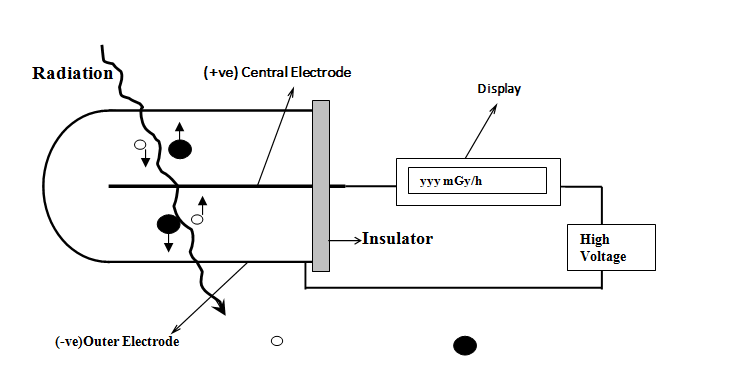Radiation Detection and Measurement Techniques
Detection and measurement of nuclear radiation must be accomplished by suitable instruments, since these radiations are invisible and their presence generally cannot be sensed by human perception. All radiation monitoring devices consist of a radiosensitive detector and a means of recording the effects of radiation on the detector (i.e. the response of the detector). Detectors respond to radiation by producing various physical effects which can be measured. Ionization is one of these effects. The ion-pairs can be collected to give an electrical signal which is related to the intensity of the radiation. Some detectors will emit light pulses in response to radiation and by counting the pulses the intensity of the radiation can be detected. Others will store the effects of ionizing radiation over a long period and can then yield the information at a later time. All these devices, in one way or other, respond to the energy deposited in them by the radiation. Instruments can be designed to indicate either the rate at which the radiation is being received or the integrated amount of radiation over a certain time period. The following are the media generally used for radiation detection.
- Gases (e.g. Ion chamber, Proportional counter, GM counter)
- Scintillators [ Na I (Tl), Anthracene, etc.]
- Solid state detectors [Semiconductors, Thermo-luminescent dosimeters etc.]
- Photographic emulsions [Film]
The selection of the detector depends on a variety of factors such as type, energy, and the level of intensity of radiation to be detected in addition to other factors such as cost, size, availability, electronics needed etc. Therefore, an understanding of different types of detectors and their characteristics is an important prerequisite for their selection and optimum use in a given situation.
Principle of Gas Filled Detectors
The most common type of detector is a gas filled radiation detector. This detector works on the principle that - as the radiation pass through air or specific gas, ionization occurs in air or molecules. Fig 1 gives the features of air or gas-filled detector. The ion-pairs produced are collected and measured as current or pulses. These are generally cylindrical in shape with two electrodes, the central electrode, and the outer sheath, separated by an insulator. When a variable voltage is applied across the electrode, the positive ions will be attracted to outer electrode (the cathode) and the negative ion will travel to the positive electrode (the anode). The charges collected by anode and cathode form a very small current across the detector. By placing a sensitive current meter across the cathode and anode, the small current can be measured and displayed as a signal. More the radiation entering the chamber, more the current is displayed by the instrument. If one measures the number of ion pairs collected across the detector at different applied voltages, the following six different regions of response would be noticed (Fig.2).
Fig.1 Gas filled Detector System
Fig.2 Response of a gas filled detector at different voltages
At low applied voltages some of the ion pairs recombine to form neutral atoms. The process of recombination decreases as the applied voltage is increased. Hence, the number of ion pairs collected increases initially with applied bias. (Region-1)
Gas Filled Radiation Detectors
The ionization chamber is a very versatile device. It can be designed in many shapes and sizes and with different filling gases. The electrode material used in the ionization chamber, the type of gas filled and its pressure and the size of the ionization chamber etc., depend on the radiation intensity to be measured. The gas used in ionization chamber for radiation monitoring is air, filled generally at atmospheric pressure. The wall material have radiation absorption and scattering characteristics identical to that of air i.e. the effective atomic number of the wall material should be close to that of air ( Z= 7.64). An instrument with such an ionization chamber will give energy independent response. Several materials such as graphite, bakelite, and teflon satisfy this requirement of air equivalence in atomic number.
Solid State Detectors
All the detectors described so far register the ionization produced by radiation in a gas. The scintillation detector works on quite a different principle: it measures radiation by detecting tiny flashes of light which radiation produces in certain materials. These light flashes, called scintillation, are converted to electrical pulses and, when fed into suitable electronics, can discriminate between different types of radiation and even between different energies of the same radiation.
There are several types off scintillation counters, but their detector systems always consist of two components which are optically coupled. The first is a scintillator. This is a solid or liquid which emits light pulses when radiation deposits energy in it. This is called the scintillation 'phosphor'. The second component is a photomultiplier tube (PMT) which converts this light pulse into a pulse of electric current.
There are scintillation detectors for alpha, beta, gamma and neutron radiation. Scintillators are made of plastic, organics, or inorganic materials. They can be solid, liquid, and gas. They can be made in all shapes and sizes. Scintillation detectors can be used with portable survey meters or fixed equipment. Incoming radiation interacts with a scintillating material and a portion of/or the total energy is transferred to the scintillating material. The excited scintillating molecules produce light photons during the de-excitation process. A NaI(Tl) detector is commonly used for gamma scintillation detection and gamma analysis. Due to the high sensitivity, NaI(Tl) detectors give high background radiation levels. The detector is shielded to reduce background radiation level before use.
Neutron Detection
Since neutrons are uncharged particles, their detection method are different from those of charged particles and gamma radiation. Neutron detection is accomplished by methods such as a) neutron induced transformation resulting in charged particles or gamma radiation, b) neutron induced transformation resulting in radioactive product nuclei, whose subsequent decay gives the information of neutron flux, and c) elastic scattering of neutrons resulting in production of charged particles. Hence a neutron detecting system is a combination of the interacting medium in which neutron produce one of the above effects and detecting medium to detect the resulting charged particles or gamma radiation.
The reaction mainly used is (n,alpha) reaction (i.e. neutrons on interacting with the medium produce alpha particles) e.g. 10B(n,alpha) 7Li. Boron-10 has a high cross section for thermal neutrons for this reaction. The alpha particles released are detected by suitable system. Boron tri-fluoride (BF3) gas filled or boron coated proportional counters are the most commonly used thermal neutron detectors. Similarly, helium-3 gas, in a proportional counter, also helps in the detection of thermal neutrons by the reaction 3He(n,p) 3H. In personnel monitoring film batch, a cadmium filter is used for the determination of thermal neutron dose. Cadmium filter gives prompt gamma radiation on absorption of thermal neutrons [113Cd (n,gamma) 114Cd] and the gamma radiation produce blackening in the film.
Radiation Monitoring Instruments
Radiation hazard evaluation is necessary in order to adopt and implement suitable measures/steps to control radiation exposure. The sources used in nucleonic gauges and well logging equipment are encapsulated and sealed. Therefore, the problem of internal hazard does not arise unless the source capsule gets ruptured during use.
It is considerably easy to estimate the external hazard and there are a number of devices (of different make) suitable for this purpose, available in the market. From the application view point, these devices may be classified in to two: the area monitoring devices and personnel monitoring devices. In area monitoring application, the Geiger-Muller (GM) counter, Ionisation chamber and Proportional counter based devices are most commonly used. The devices measure either the radiation intensity or exposure (exposure rates). But in personnel monitoring, pocket dosimeters or personnel dose monitoring badge, loaded with photo-sensitive film or Thermo-Luminescent Dosimeters (TLD) are used. The personnel dosimeters recorded the cumulated radiation dose over a period of use.
Personnel monitoring is the evaluation of radiation doses received by the personnel working with radiation sources.


Fig 3: Personnel Monitoring Badges
Till 1990, the most commonly used personnel monitoring device in our country was the film badge which consists of a photographic film kept in a cassette containing a set of filters [Fig. 3 A]. Using film badges doses from 0.1 mSv to 10 Sv (10 mrem to 1000 rem) of different types of radiation (beta, gamma, x-rays and thermal neutrons) can be evaluated. The film serves as a permanent record and if worn on chest gives the most representative value of radiation dose received by the whole body dose under normal working conditions. Films can be used to assess the radiation dose received from exposure to beta rays, x-rays, gamma rays or thermal neutrons. Thermal neutrons can not affect the film directly. They are detected through emission of gamma radiations by cadmium on absorption of thermal neutrons. For fast neutron monitoring a special NTA film is used. This film records tracks of recoil protons formed due to interaction of fast neutrons with hydrogen atoms. The recoil proton tracks are counted and correlated with fast neutron dose.
Now a days, the radiation dose received by workers is determined by the use of thermo-luminescent dosimeters (TLD) badges. This consists of three CaSO4 :Dy TLD discs embedded in a metallic framework and enclosed in a multi-filter cassette (Fig 3 B). The TLD badge can be used to monitor beta, gamma and x-radiations. The TLD badge can cover a wide range of doses from 0.1 mSv to 10 Sv (10 mrem to 1000 rem).
Radiation dose to personnel can also be assessed by wearing pocket dosimeters. Pocket dosimeters are very useful in certain operations, where the radiation levels vary considerably and may be quite hazardous. They give on the spot information of radiation doses, as the dose recorded can be read directly by the person. Pocket dosimeters are available for determination of exposures up to 2 mGy, 50 mGy and 100 mGy etc., (200 mR, 5 R, 10 R) [Fig. 4]. The pocket dosimeters have a built-in capacitance which can be charged by an external potential and when exposed to radiation the ionization produced in the chamber decreases the voltage across the capacitance. The reduction in the voltage across the capacitance is a measure of the amount of ionization and hence the quantity of radiation exposure. In the self-reading type pocket dosimeters, a fiber electrometer an eye piece raticule is incorporated in the ionization chamber capacitance unit. These can be charged by an external voltage supply and the discharge can be read from the eye piece graticule by looking through it against some light illumination (Fig. 4).


Fig. 4: Pocket Dosimeter









